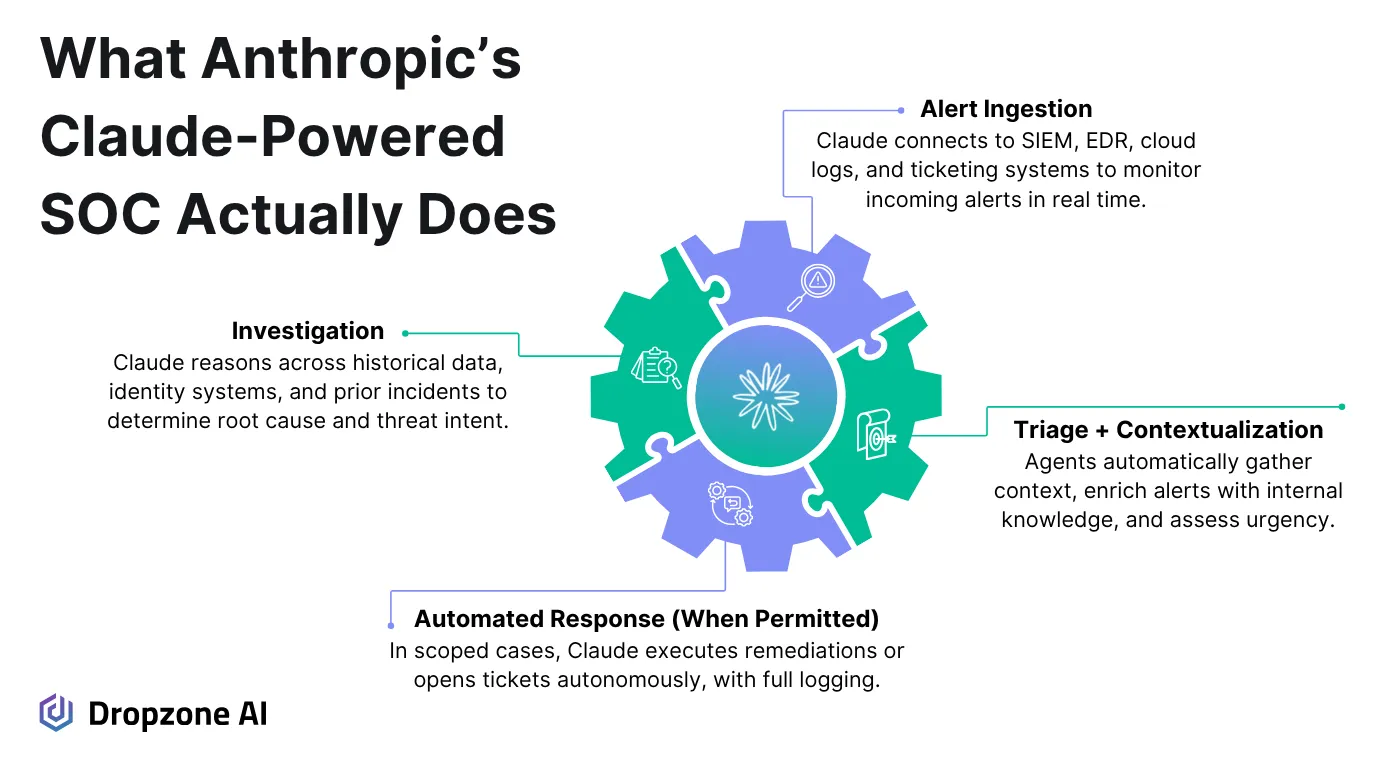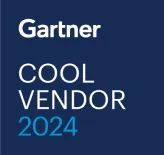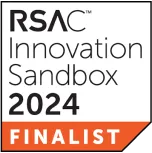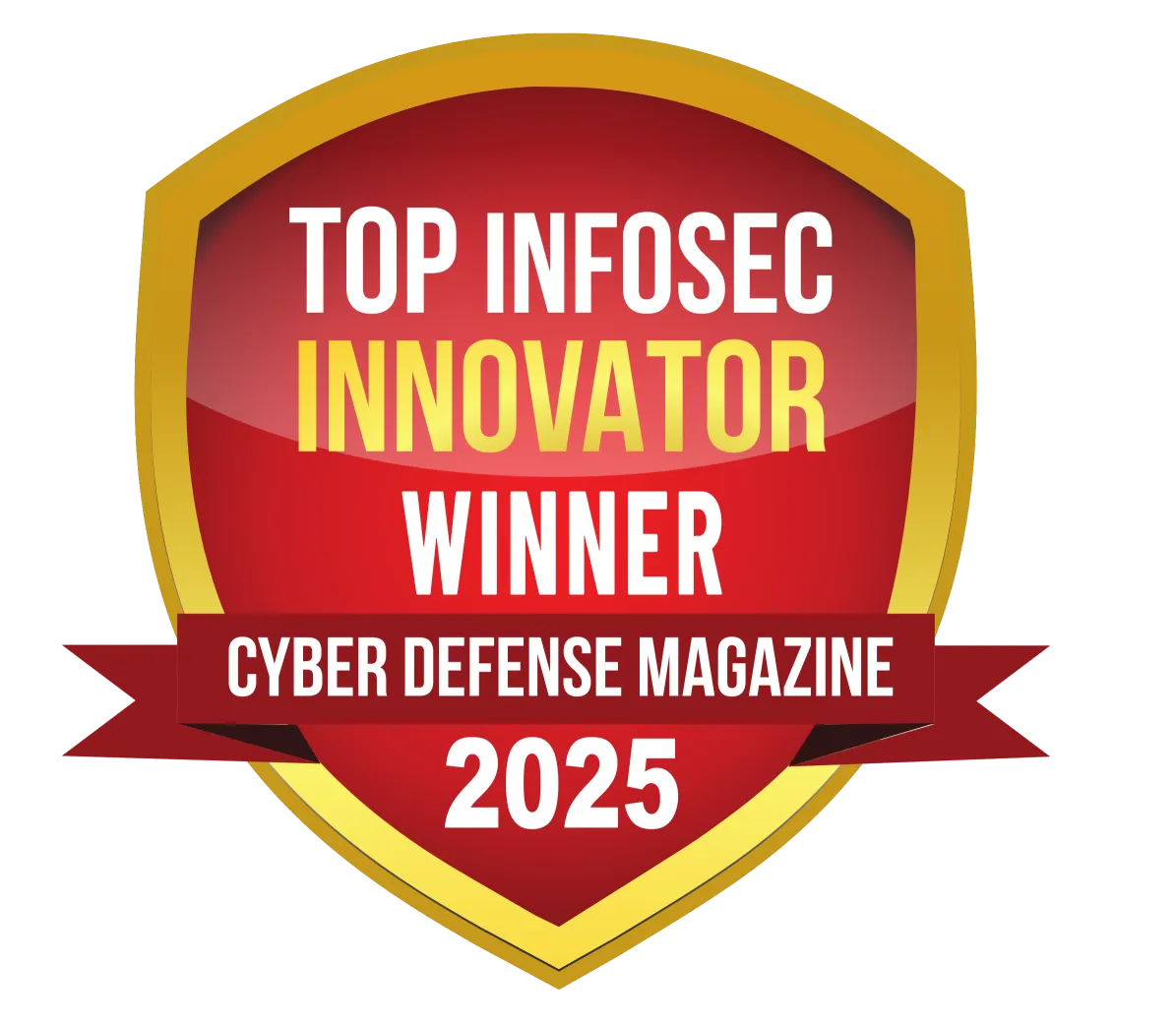Introduction
AI is transforming how modern SOCs operate, but most teams are still stuck in reactive mode. Common challenges include:
- Tools don't talk to each other
- Alerts pile up faster than teams can handle
- Analysts burn out from repetitive triage work
And despite growing investments in automation, real efficiency remains elusive.
Anthropic took a different path. They built an AI SOC, powered end-to-end by their own model, Claude. It's not just an incremental improvement; it's a radically reimagined security operation designed for speed, volume, and resilience.
In this article, we'll unpack how they did it and what that means for the rest of us. Because while few organizations can build a SOC like Anthropic's, there is a smarter, more achievable way forward for teams looking to modernize using AI without starting from scratch.
What Did Anthropic Build?

How Does Claude Replace the Traditional SOC?
At RSA 2025, Jason Clinton, Anthropic's CISO, made a statement that turned heads: they no longer operate a traditional security operations center. There's no L1 or L2 team watching dashboards or triaging alerts. Instead, Anthropic’s Claude series of large language models has taken on many of those responsibilities across the investigative workflow. This isn't a theoretical pilot or an automation script.
At BSides SF 2025, Anthropic Technical Staff Members Jackie Bow and Peter Sanford explained how they built this system. You can watch their presentation here: AI's Bitter Lesson for SOCs: Let Machines Be Machines.
Bow and Sanford explained that the system runs Claude as a foundation model without modification, no fine-tuning required. Instead, it's given rich investigative context through:
- External information sources
- A long-term memory and knowledge store
- A set of security tools it can call on during an investigation
This combination enables the AI to pull in relevant data, correlate across different systems, and follow investigative workflows effectively, all while working within clear guardrails.
For example, the team shared a sample investigation prompt they use with Claude. It includes:
- The triggering alert
- The detection rule that fired
- A list of relevant data sources
- Clear investigative guidance
By embedding this kind of security knowledge directly into Claude's working context, they enable accurate, context-aware analysis without fine-tuning the model.
Claude performs multiple investigative functions:
- Investigates alerts autonomously
- Correlates telemetry across systems
- Pulls identity information
- Executes responses within predefined boundaries
These aren't isolated tasks. Claude acts on them as part of a cohesive investigative workflow that spans detection, validation, and action.
What Architecture Makes This Possible?
What makes this work is how deeply Claude is integrated into Anthropic's internal systems, giving it the context it needs to operate accurately.
Guardrails are built into every layer of the system. Claude isn't operating in a vacuum, which would more likely lead to hallucinations. Trust is added to the system:
- Logs every action for audit trails
- Includes reasoning traces for transparency
- Routes edge cases to human operators when needed
The team intentionally designed these controls to guarantee that the output is safe, explainable, and consistent with internal policies and procedures.
Beyond handling individual alerts, Claude can also perform meta-analysis, reviewing large sets of lower-confidence signals to detect trends or anomalies that may not be obvious in isolation. This helps surface subtle threats and patterns that might otherwise go unnoticed.
The result isn't a tool that helps humans work faster; it's a system that handles the work itself, while still integrating seamlessly into the company's security management at volume.
Why Does This Work for Anthropic But Not Others?
What Is Anthropic's Unique Advantage?
Anthropic didn't just integrate an AI model into their SOC; they spent a lot of engineering effort integrating Claude into their systems. But rather than fine-tuning it for security operations, the team uses the foundation model entirely without modification. Their real advantage is the AI expertise to design agentic systems that embed security knowledge and context directly into workflows.
There's no abstraction layer between their security team and the model. That expertise lets them craft:
- Prompts that provide investigative context
- Toolchains that connect to security data sources
- Memory systems that retain investigation history
These give Claude the right context to investigate alerts, correlate data, and make decisions without training the model.
The SOC isn't tightly coupled to a single model version, either because the orchestration layer is its own. Anthropic can swap in improved models as they're released, preserving flexibility while still maintaining deep integration with their security stack.
They've also wired Claude directly into their internal systems. The agents aren't bolted onto a vendor platform; they're embedded into Anthropic's existing infrastructure so that Claude can access relevant security data sources through Anthropic's custom-built tools.
When their agents investigate or respond to a threat, they're not waiting on third-party middleware to execute; they're executing within Anthropic's own infrastructure. That's possible because they control their orchestration layer end-to-end.
Should Other Organizations Try to Replicate This?
For security teams, this level of engineering isn't an option. In fact, many of them are barely beginning to experiment with vendor-provided copilots or LLM integrations.
Their stack is a patchwork of best-of-breed tools, which makes sense for most businesses; however, this also means they have limited influence over how these tools share data or coordinate a response. Even if they had access to an AI agent, they wouldn't be able to plug it into their SOC without building integrations (pre-training the agent to use those tools expertly).
Teams aren't ready to hand over investigation or response decisions to an agent without testing, regardless of how advanced it is. The controls, observability, and governance are just not there. And building those layers, if you don't already have them, is a long-term effort that many teams can't justify against more immediate security priorities.
Why Does Dropzone AI Make Sense for Everyone Else?
How Does Dropzone Provide Scoped Autonomy?
Dropzone AI provides security teams with a practical way to quickly introduce autonomous AI SOC agents without requiring deep agentic AI expertise. Its AI SOC analyst works out-of-the-box and is designed for teams that want to:
- Reduce alert fatigue
- Speed up investigation timelines
- Standardize response workflows
All without hiring a team of AI engineers, laying down governance and control foundations, and building integrations with their toolset.
The automation that Dropzone AI provides is scoped, auditable, and works with existing security tooling. There are no scripts, coding, or playbooks that you have to write to get it working—it can deliver value on Day 1. See the Dropzone AI demo gallery for dozens of ungated product tours showing how it autonomously investigates alerts from your SIEM, EDR, and more.
Where Claude is embedded deeply into every layer of Anthropic's environment, Dropzone integrates more like a system overlay. It receives alerts from your security tools and investigates to produce detailed reports with a conclusion and evidence. It is pre-trained to use tools expertly and integrates simply with:
- SIEMs for alert ingestion
- EDRs for endpoint telemetry
- Ticketing tools for case management
- And many other tools that are in the environment
This automates repetitive triage tasks and expands investigation context, replicating the investigative process of your human expert analysts.
That saves time without handing over full control. You still get intelligent prioritization, enrichment, and decision support, but it happens with clear boundaries and built-in oversight.
What Makes Dropzone's Approach More Practical?
Most organizations shouldn't recreate what Anthropic built. Even if you had the AI capability, the engineering effort to wire it safely into your production environment would be massive.
Dropzone meets teams where they are. It provides a measurable upgrade in response speed and decision quality, but without requiring internal model tuning or deep system rewiring. It comes with governance features such as role-based access control, system event logs, an evidence locker, and fully transparent investigations showing reasoning.
You also don't have to make big leaps of trust; Dropzone operates transparently:
- Logs its actions for auditability
- Stays within defined scopes
- Explains why something was identified or escalated
For most companies, striking a balance between control and automation makes more sense. You gain acceleration where it counts, while still maintaining human review, compliance, and operational safety.
Conclusion
Anthropic's AI SOC showcases what's possible when you control everything from the core model to the security stack. But most teams aren't built to do it all in-house, and they shouldn't have to be.
Dropzone AI brings that same level of speed, automation, and intelligent triage to security teams everywhere, without the need for a big upfront and ongoing engineering commitment. See how it transforms your workflow: Try our self-guided demo and experience what modern security operations can look like.















